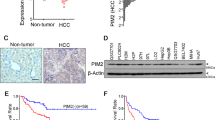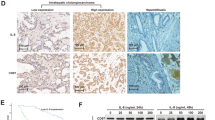Abstract
Background
Interleukin-22 (IL-22) is a pro-inflammatory cytokine released during the immune response in chronic liver injury. Although IL-22 mediates tissue regeneration, its uncontrolled production may generate a carcinogenic environment resulting in hepatocellular carcinoma (HCC). This study aims to identify the effect of IL-22 on anti-apoptotic and metastatic genes and the molecular pathways responsible for IL-22-mediated hepatic carcinogenesis.
Methods and results
Three cancerous liver lines, HepG2, SNU-387, Huh7, and one normal liver line, THLE2, were treated with IL-22. RT-qPCR analysis was conducted to study the role of IL-22 in altering the expression levels of anti-apoptotic genes, MCL-1 and BCL-2, and metastatic genes, MMP-7 and MMP-9. A significant increase in expression levels of these genes was observed after IL-22 treatment. Furthermore, to explore the major pathways involved in IL-22-mediated upregulation of anti-apoptotic and metastatic genes, cells were treated with inhibitors of JAK/STAT and PI3K/AKT pathways along with IL-22. Resultantly, a significant decrease in expression levels of target genes was observed, indicating the involvement of JAK/STAT and PI3K/AKT signaling cascades in IL-22-mediated oncogenesis. Finally, Cell Scratch assay was performed to check the effect of IL-22 and inhibitors of JAK/STAT and PI3K/AKT on the metastatic potential of liver cells. While migration was observed in Huh7 and THLE2 cells treated with IL-22, no migration was observed in cells treated with IL-22 along with JAK/STAT and PI3K/AKT inhibitors. Results indicate that IL-22 encourages metastasis in HCC cells via the JAK/STAT and PI3K/AKT pathways.
Conclusion
Results showed that IL-22 upregulates anti-apoptotic and metastatic genes in HCC through JAK/STAT and PI3K/AKT signaling pathways.






Similar content being viewed by others
Data availability
Data sharing is not applicable to this article as no datasets were generated or analyzed during the current study.
Abbreviations
- IL-22:
-
Interleukin-22
- HCC:
-
Hepatocellular carcinoma
- JAK:
-
Janus kinase
- STAT:
-
Signal transducer and activator of transcription
- AKT:
-
Protein kinase B
- PI3K:
-
Phosphoinositide 3-kinases
- MCL:
-
Myeloid cell leukemia
- BCL:
-
B-cell lymphoma
- MMP:
-
Matrix metalloproteinase
References
Llovet JM et al (2022) Immunotherapies for hepatocellular carcinoma. Nat Rev Clin Oncol 19(3):151–172
Bhatti ABH (2021) Hepatocellular carcinoma in Pakistan: an update. Liver Cancer Middle East 387–396
Kulik L, El-Serag HB (2019) Epidemiology and management of hepatocellular carcinoma. Gastroenterology 156(2):477.e1-491.e1
McGlynn KA, Petrick JL, El-Serag HB (2021) Epidemiology of hepatocellular carcinoma. Hepatology 73:4–13
Steuerwald NM et al (2013) Profiles of serum cytokines in acute drug-induced liver injury and their prognostic significance. PLoS ONE 8(12):e81974
Pellicoro A et al (2014) Liver fibrosis and repair: immune regulation of wound healing in a solid organ. Nat Rev Immunol 14(3):181–194
Sharma A, Nagalli S (2021) Chronic liver disease. In: StatPearls [Internet]. StatPearls Publishing
Berumen J et al (2021) Liver fibrosis: pathophysiology and clinical implications. WIREs Mech Dis 13(1):e1499
Yu L-X, Ling Y, Wang H-Y (2018) Role of nonresolving inflammation in hepatocellular carcinoma development and progression. NPJ Precis Oncol 2(1):6
Léveillé M, Estall JL (2019) Mitochondrial dysfunction in the transition from NASH to HCC. Metabolites 9(10):233
Qin S et al (2014) Th22 cells are associated with hepatocellular carcinoma development and progression. Chin J Cancer Res 26(2):135
Shi J et al (2020) Interleukin 22 is related to development and poor prognosis of hepatocellular carcinoma. Clin Res Hepatol Gastroenterol 44(6):855–864
McGee HM et al (2013) IL-22 promotes fibroblast-mediated wound repair in the skin. J Investig Dermatol 133(5):1321–1329
Alcorn JF (2020) IL-22 plays a critical role in maintaining epithelial integrity during pulmonary infection. Front Immunol 11:1160
Xu M-J et al (2014) IL-22 ameliorates renal ischemia-reperfusion injury by targeting proximal tubule epithelium. J Am Soc Nephrol 25(5):967–977
Arshad T et al (2020) A double edged sword role of interleukin-22 in wound healing and tissue regeneration. Front Immunol 11:2148
Shohan M et al (2020) Interleukin-22 and intestinal homeostasis: Protective or destructive? IUBMB Life 72(8):1585–1602
Wu Y et al (2020) Interleukin 22 in liver injury, inflammation and cancer. Int J Biol Sci 16(13):2405
Sabat R, Ouyang W, Wolk K (2014) Therapeutic opportunities of the IL-22–IL-22R1 system. Nat Rev Drug Discov 13(1):21–38
Carmo RF, Cavalcanti MS, Moura P (2017) Role of Interleukin-22 in chronic liver injury. Cytokine 98:107–114
Lim C, Savan R (2014) The role of the IL-22/IL-22R1 axis in cancer. Cytokine Growth Factor Rev 25(3):257–271
Jiang R et al (2011) Interleukin-22 promotes human hepatocellular carcinoma by activation of STAT3. Hepatology 54(3):900–909
Hernandez P, Gronke K, Diefenbach A (2018) A catch-22: Interleukin-22 and cancer. Eur J Immunol 48(1):15–31
Owen KL, Brockwell NK, Parker BS (2019) JAK-STAT signaling: a double-edged sword of immune regulation and cancer progression. Cancers 11(12):2002
Ji Y et al (2014) IL-22 promotes the migration and invasion of gastric cancer cells via IL-22R1/AKT/MMP-9 signaling. Int J Clin Exp Pathol 7(7):3694
Wang H et al (2021) Targeting MCL-1 in cancer: current status and perspectives. J Hematol Oncol 14(1):1–18
Zhang L, Lu Z, Zhao X (2021) Targeting Bcl-2 for cancer therapy. Biochim Biophysica Acta 1876(1):188569
Scheau C et al (2019) The role of matrix metalloproteinases in the epithelial-mesenchymal transition of hepatocellular carcinoma. Anal Cell Pathol 2019
Dambacher J et al (2008) The role of interleukin-22 in hepatitis C virus infection. Cytokine 41(3):209–216
Radaeva S et al (2004) Interleukin 22 (IL-22) plays a protective role in T cell-mediated murine hepatitis: IL-22 is a survival factor for hepatocytes via STAT3 activation. Hepatology 39(5):1332–1342
Jiang R et al (2013) IL-22 is related to development of human colon cancer by activation of STAT3. BMC Cancer 13:1–11
Andoh A et al (2005) Interleukin-22, a member of the IL-10 subfamily, induces inflammatory responses in colonic subepithelial myofibroblasts. Gastroenterology 129(3):969–984
Wolk K et al (2006) IL-22 regulates the expression of genes responsible for antimicrobial defense, cellular differentiation, and mobility in keratinocytes: a potential role in psoriasis. Eur J Immunol 36(5):1309–1323
Dudakov JA, Hanash AM, van den Brink MR (2015) Interleukin-22: immunobiology and pathology. Annu Rev Immunol 33:747–785
Wolk K et al (2010) Biology of interleukin-22. In: Seminars in immunopathology. Springer
Kulkarni OP et al (2014) Toll-like receptor 4–induced IL-22 accelerates kidney regeneration. J Am Soc Nephrol 25(5):978–989
Nguyen HMH et al (2020) Nicotine impairs the response of lung epithelial cells to IL-22. Mediators Inflamm 2020
Takahashi K et al (2011) (2011) IL-22 attenuates IL-25 production by lung epithelial cells and inhibits antigen-induced eosinophilic airway inflammation. J Allergy Clin Immunol 128(5):1067.e6-1076.e6
Kryczek I et al (2014) IL-22+ CD4+ T cells promote colorectal cancer stemness via STAT3 transcription factor activation and induction of the methyltransferase DOT1L. Immunity 40(5):772–784
Sestito R et al (2011) STAT3-dependent effects of IL-22 in human keratinocytes are counterregulated by sirtuin 1 through a direct inhibition of STAT3 acetylation. FASEB J 25(3):916–927
Wolk K et al (2004) IL-22 increases the innate immunity of tissues. Immunity 21(2):241–254
Wu T et al (2014) Interleukin 22 protects colorectal cancer cells from chemotherapy by activating the STAT3 pathway and inducing autocrine expression of interleukin 8. Clin Immunol 154(2):116–126
Yu L-Z et al (2013) Expression of interleukin-22/STAT3 signaling pathway in ulcerative colitis and related carcinogenesis. World J Gastroenterol 19(17):2638
Lejeune D et al (2002) Interleukin-22 (IL-22) activates the JAK/STAT, ERK, JNK, and p38 MAP kinase pathways in a rat hepatoma cell line: pathways that are shared with and distinct from IL-10. J Biol Chem 277(37):33676–33682
Cho K-A et al (2012) Interleukin-17 and interleukin-22 induced proinflammatory cytokine production in keratinocytes via inhibitor of nuclear factor κB kinase-α expression. Ann Dermatol 24(4):398–405
Mitra A, Raychaudhuri SK, Raychaudhuri SP (2012) IL-22 induced cell proliferation is regulated by PI3K/Akt/mTOR signaling cascade. Cytokine 60(1):38–42
Weber GF et al (2006) IL-22-mediated tumor growth reduction correlates with inhibition of ERK1/2 and AKT phosphorylation and induction of cell cycle arrest in the G2-M phase. J Immunol 177(11):8266–8272
Perusina Lanfranca M et al (2016) Biological and pathological activities of interleukin-22. J Mol Med 94:523–534
Funding
This study was funded by the National University of Sciences and Technology, Pakistan (Grant: Students’ Research Funds).
Author information
Authors and Affiliations
Contributions
Authors Fizzah Mansur, Tanzeela Arshad, and Sobia Manzoor contributed equally to the work. All authors read and approved the final manuscript.
Corresponding author
Ethics declarations
Competing interests
The authors have no relevant financial or non-financial competing interests to disclose.
Ethical approval
This article does not contain any studies with human participants or animals performed by any of the authors.
Additional information
Publisher's Note
Springer Nature remains neutral with regard to jurisdictional claims in published maps and institutional affiliations.
Rights and permissions
Springer Nature or its licensor (e.g. a society or other partner) holds exclusive rights to this article under a publishing agreement with the author(s) or other rightsholder(s); author self-archiving of the accepted manuscript version of this article is solely governed by the terms of such publishing agreement and applicable law.
About this article
Cite this article
Mansur, F., Arshad, T., Liska, V. et al. Interleukin-22 promotes the proliferation and migration of hepatocellular carcinoma cells via the phosphoinositide 3-kinase (PI3K/AKT) signaling pathway. Mol Biol Rep 50, 5957–5967 (2023). https://doi.org/10.1007/s11033-023-08542-x
Received:
Accepted:
Published:
Issue Date:
DOI: https://doi.org/10.1007/s11033-023-08542-x




